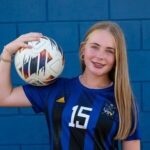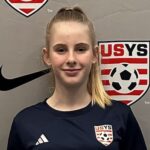Ask Michael Bradley: Ankle sprains are part of the game
Editor’s note: This is the latest blog post from Dr. Wendy Lebolt, a longtime coach and physiologist who is the founder of Fit2Finish, a Northern Virginia-based training, fitness and rehabilitation company which works with teams and individual players to maximize health and performance. The Soccer Wire is excited to present Wendy’s learned perspectives on the mental, physical and psychological aspects of the beautiful game. Learn more about her background here.
I’m REALLY glad I wasn’t standing next to U.S. Men’s National Team coach Jurgen Klinsmann when Michael Bradley turned his ankle in warm-ups before their game against Costa Rica on Friday. What a nightmare. Your crucial central midfielder wrenches his ankle and is screaming in pain. What do you do?
Well, Klinsmann has resources the rest of us mere human coaches don’t have. He’s got trainers and a medical staff. They’ve got the know-how to make the call at the field. Diagnosis: second-degree ankle sprain. The first question: Can he continue? When the answer is no, the next question: How long will he be out? That one’s tougher. Bradley heads for an MRI after the game. Klinsmann and the USMNT wait for the orthopedic report.
Kids go down with a turn of the ankle on every field, every day. How do we know whether it’s serious? Can they continue? Should they? Even if you haven’t loaded up on your medical training, you can make an informed decision. In fact, your players are counting on this.
Quick primer (for more information, see here):
- Grade I Ankle Sprain: Grade I ankle sprains cause stretching of the ligament. The symptoms tend to be limited to pain and swelling. Most patients can walk without crutches, but may not be able to jog or jump.
- Grade II Ankle Sprain: A grade II ankle sprain is more severe partial tearing of the ligament. There is usually more significant swelling and bruising caused by bleeding under the skin. Patients usually have pain with walking, but can take a few steps.
- Grade III Ankle Sprain: Grade III ankle sprains are complete tears of the ligaments. The ankle is usually quite painful, and walking can be difficult. Patients may complain of instability, or a giving-way sensation in the ankle joint.
Not a doctor? Not a problem. Take a look at the kid and at the ankle. Pain? Swelling? Bruising? If the answer to any is a definitive yes, then the kid’s play-day is done. For Michael, the Grade II sprain put him on the bench. The immediate treatment is the well known “R-I-C-E” – rest, ice, compression, elevation. So, be sure you have an ice pack in your bag for these emergencies and be sure you know how to use it. (True confession: I have failed miserably with these “chemical packs.” Pharmaceutical companies, are you listening???)
But don’t stop there. Compression means wrap it tightly with an ACE-type elastic wrap. This is uncomfortable when applied, but it holds the ice securely to the painful joint. And the compression will make the ankle feel better. Don’t forget the elevation. This is tough on the sidelines during the game. I have put them on the ground with their foot propped up on their bag.
Now comes the tough part. When can they return to play? Michael’s injury required an MRI, and doctors have determined he is unavailable for the next game. Michael is a professional and decisions for him are made by professionals. If your injured player cannot walk, has noticeable ankle swelling or pain that continues beyond a day or two, or has pain in the foot or above the ankle, he should see a pro too. Let the doctor tell you what should come next.
Once your kid is approved for play, be delighted. Just like Mr. Klinsmann will be when Michael Bradley gets the okay. I would LIKE to be standing near him then. That’s cause for celebration. BUT, that’s when your job really begins, because here’s the bad news: 75 percent of sprained ankles are re-sprained.
Anyone who’s sprained an ankle knows this. Once you stretch those ligaments, they stay just a bit lax. That’s because ligaments aren’t designed to stretch; they’re meant to remain taut to hold bones in place (see my article about joints here). A sprained ankle requires time to mend what’s torn, and the less weight it has to bear in the process the better. That’s why Michael is on crutches. Often, a splint or inflatable cast is helpful.
Before the kid returns to play:
- the ankle should be pain free and have full range of motion. Compare it with the other one.
- he should have good strength. Have him rise up on both toes and hold himself there. Compare again.
- he should be able to execute starts and stops and changes of direction without a break in form.
A player returning after an injury or with a history of ankle sprains may need to wear a brace or ankle sleeve to play. This should NOT take the place of their other job: strengthening. Join Mr. Bradley in the effort. Consider it a permanent part of your training. Because stretched-out ligaments stay somewhat stretched, even long after the tears or ruptures are healed. Your best chance of staying injury-free is to strengthen the muscles around the joint as a “natural splint.”
All this and you’ve got your central midfielder back, Mr. Klinsmann – words that he and millions of USMNT fans will be delighted to hear. All the best to you, Michael. We can’t wait to see you back in action.
SOCCERWIRE MARKETPLACE
- Capital Fall Classic 2025 - Register by October 1st
- Applications are Now Open for the 2026 Jefferson Cup
- Start the Season Strong at Loudoun Premier Cup!
- 50th Annual Rael Vodicka Memorial Tournament
- Soccer Marketing Internships at The St. James FC
- Job Opening: The St. James FC Goalkeeper Academy Coach
- Full-Time Director of Goalkeeping for The St. James FC
- visitRaleigh.com Showcase Series 2025, hosted by NCFC Youth
- Join Official Elite Summer Soccer Camps with Europe’s Top Pro Clubs!
- OFFICIAL BAYERN MUNICH SUMMER CAMPS U.S.











